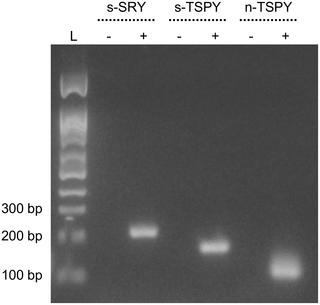Our official English website, www.x-mol.net, welcomes your
feedback! (Note: you will need to create a separate account there.)
A novel nested polymerase chain reaction targeting the testis-specific protein Y-encoded family of genes for high sensitivity of recent semen exposure detection: Comparison with four other assays of semen detection.
PLOS ONE ( IF 2.9 ) Pub Date : 2019-07-25 , DOI: 10.1371/journal.pone.0220326 Katia Giguère 1, 2 , François A Leblond 3 , Ella Goma-Matsétsé 4 , Vibhuti Dave 3 , Luc Béhanzin 1, 4, 5 , Fernand A Guédou 1, 4 , Michel Alary 1, 2, 6
PLOS ONE ( IF 2.9 ) Pub Date : 2019-07-25 , DOI: 10.1371/journal.pone.0220326 Katia Giguère 1, 2 , François A Leblond 3 , Ella Goma-Matsétsé 4 , Vibhuti Dave 3 , Luc Béhanzin 1, 4, 5 , Fernand A Guédou 1, 4 , Michel Alary 1, 2, 6
Affiliation

|
OBJECTIVES
Because self-report of sexual behaviours is prone to biases, biomarkers of recent semen exposure are increasingly used to assess unprotected sex. We aimed to present a novel nested polymerase chain reaction (PCR) assay targeting testis-specific protein Y-encoded (TSPY) genes and to compare its performance in detecting recent semen exposure with that of four other assays.
METHODS
Forty-five vaginal samples were selected at baseline of a prospective observational demonstration study of early antiretroviral treatment and pre-exposure prophylaxis among female sex workers in Benin. Semen exposure was assessed with: a rapid prostate-specific antigen (PSA) detection assay, a quantitative PCR targeting the sex-determining region (SRY) gene, a standard PCR targeting SRY, a standard PCR targeting TSPY, and a nested PCR targeting TSPY (n-TSPY). Because we had hypothesized that n-TSPY would be the most sensitive of the five assays while remaining specific, and as our results suggested that it was the case, sensitivity and specificity were calculated for each assay in comparison with n-TSPY.
RESULTS
The n-TSPY could detect male DNA at concentration 16 and 64 times lower compared to s-TSPY and s-SRY, respectively. Among the 45 vaginal samples, prevalences of semen exposure according to the different assays varied from 22.2% (95%CI: 11.2%-37.1%) to 70.5% (95%CI: 54.8%-83.2%), with the highest prevalence measured with n-TSPY. The n-TSPY products were of expected size and we observed no false-positive in female DNA controls. The assay that offered the second best performance in detecting semen exposure was the PSA rapid test, with a sensitivity of 61.3% and a specificity of 100% compared to n-TSPY.
CONCLUSIONS
Compared to n-TSPY, all other PCR assays had poor performance to detect semen exposure. The n-TSPY is an accessible assay that may have great utility in assessing semen exposure in studies where many factors are expected to accelerate biomarkers' clearance.
中文翻译:

针对睾丸特异性蛋白Y编码的基因家族的新型巢式聚合酶链反应,用于近期精液暴露检测的高灵敏度:与其他四个精液检测方法的比较。
目的由于性行为的自我报告容易产生偏差,因此最近精液暴露的生物标志物越来越多地用于评估未受保护的性行为。我们旨在介绍针对睾丸特异性蛋白Y编码(TSPY)基因的新型巢式聚合酶链反应(PCR)检测方法,并将其在检测最近的精液接触方面的性能与其他四个检测方法进行比较。方法在贝宁女性性工作者的早期抗逆转录病毒治疗和暴露前预防的前瞻性观察观察研究的基线中,选择了45个阴道样本。精液暴露的评估包括:快速前列腺特异性抗原(PSA)检测分析,靶向性别决定区域(SRY)基因的定量PCR,靶向SRY的标准PCR,靶向TSPY的标准PCR和靶向TSPY的巢式PCR (n-TSPY)。因为我们假设n-TSPY将是五种测定法中最敏感的,同时仍保持特异性,并且我们的结果表明确实如此,因此与n-TSPY相比,每种测定法的灵敏度和特异性均得到了计算。结果n-TSPY检测到的男性DNA浓度分别比s-TSPY和s-SRY低16倍和64倍。在45个阴道样本中,根据不同的检测方法,精液暴露的患病率从22.2%(95%CI:11.2%-37.1%)到70.5%(95%CI:54.8%-83.2%)不等,测得的患病率最高使用n-TSPY。n-TSPY产物具有预期的大小,我们在雌性DNA对照中未观察到假阳性。PSA快速测试是检测精液暴露第二好的方法,灵敏度为61。与n-TSPY相比,特异性为3%,特异性为100%。结论与n-TSPY相比,所有其他PCR分析的精液暴露性能均较差。n-TSPY是一种易于使用的测定方法,在许多因素有望加速生物标志物清除的研究中,它在评估精液暴露方面可能具有很大的实用性。
更新日期:2019-07-26
中文翻译:

针对睾丸特异性蛋白Y编码的基因家族的新型巢式聚合酶链反应,用于近期精液暴露检测的高灵敏度:与其他四个精液检测方法的比较。
目的由于性行为的自我报告容易产生偏差,因此最近精液暴露的生物标志物越来越多地用于评估未受保护的性行为。我们旨在介绍针对睾丸特异性蛋白Y编码(TSPY)基因的新型巢式聚合酶链反应(PCR)检测方法,并将其在检测最近的精液接触方面的性能与其他四个检测方法进行比较。方法在贝宁女性性工作者的早期抗逆转录病毒治疗和暴露前预防的前瞻性观察观察研究的基线中,选择了45个阴道样本。精液暴露的评估包括:快速前列腺特异性抗原(PSA)检测分析,靶向性别决定区域(SRY)基因的定量PCR,靶向SRY的标准PCR,靶向TSPY的标准PCR和靶向TSPY的巢式PCR (n-TSPY)。因为我们假设n-TSPY将是五种测定法中最敏感的,同时仍保持特异性,并且我们的结果表明确实如此,因此与n-TSPY相比,每种测定法的灵敏度和特异性均得到了计算。结果n-TSPY检测到的男性DNA浓度分别比s-TSPY和s-SRY低16倍和64倍。在45个阴道样本中,根据不同的检测方法,精液暴露的患病率从22.2%(95%CI:11.2%-37.1%)到70.5%(95%CI:54.8%-83.2%)不等,测得的患病率最高使用n-TSPY。n-TSPY产物具有预期的大小,我们在雌性DNA对照中未观察到假阳性。PSA快速测试是检测精液暴露第二好的方法,灵敏度为61。与n-TSPY相比,特异性为3%,特异性为100%。结论与n-TSPY相比,所有其他PCR分析的精液暴露性能均较差。n-TSPY是一种易于使用的测定方法,在许多因素有望加速生物标志物清除的研究中,它在评估精液暴露方面可能具有很大的实用性。





























 京公网安备 11010802027423号
京公网安备 11010802027423号